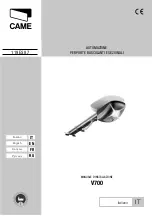
www.parweld.co.uk
10
13) Press the toggle button (D) to move the LED to
the final current (L) This can be adjusted from 5 to
200AMPs. The value is displayed on the Multifunction
display (G).
14) Press the toggle button (D) to move the LED to
the Post Gas time (M) This can be adjusted from 0.1 to
10s. The value is displayed on the Multifunction display
(G). 3s is a good initial setting.
15) Press the toggle button (D) to move the LED to
the AC frequency (P) This can be adjusted from 50 to
250Hz dependant on the welding amperage. The value
is displayed on the Multifunction display (G). 60hz is a
good initial setting. Increasing the frequency has the
effect of stiffening and focussing the arc making it good
for welding close to threads or for crater filling
Note the maximum frequency available depends upon
the welding amperage selected
<50A
50 to 250Hz
50-100A 50-200Hz
100-150A max 150Hz
150-200A max 100Hz
16) Press the toggle button (D) to move the LED
to the AC balance (Q) This can be adjusted from 15
to 50%. The value is displayed on the Multifunction
display (G). 15% is a good initial setting. Increasing the
percentage has the effect of increasing the time the
arc spends in the electrode positive state which gives
a greater cleaning effect on the material but will reduce
weld speed. For good clean material you should be
able to keep the cleaning percentage set at 15 to 20%.
You are now ready to weld. The above settings are
a guide and you should adjust to suit the job you are
welding if you are unfamiliar with the machine try to
adjust only one parameter at a time so you become
familiar with its effect.
6.3.3 tIG Welding with pulse
Function
It is possible to use the pulse function with both
AC and DC TIG welding Power Pulsing can give
significant advantages on thinner material to control
heat and penetration.
1) Follow the setup as previously described for AC or
DC TIG welding.
2) Press button A to switch on the pulsing functions
6.3.2 aC tIG Welding (no pulse)
1) Connect the torch to the - connection and the gas
hose to the gas outlet.
2) Connect the trigger control plug on the torch to the
trigger socket.
3) Connect the Earth lead to the + connection.
4) Set the process mode to 2T or 4T if you prefer a
latching trigger action. (Note in 4T position you must
press and release to start the process and press and
release again to stop the process) (A)
O
pera
t
IO
n
H
A
B
C
F
D
E
G
D
I
J
K
L
M
O
P
Q
5) Select AC output (B)
6) Select HF start (C)
7) Using the toggle buttons (D)move the illuminated
LED to the gas pre-flow position (E)
8) Adjust the parameter value by rotating the knob (F)
This can be adjusted from 0.1 to 1.0 seconds. The
value is displayed on the Multifunction display (G)
9) Press the toggle button (D) to move the LED to
the initial current (H) This can be adjusted from 5 to
200AMPs. The value is displayed on the Multifunction
display (G).
10) Press the toggle button (D) to move the LED to the
slope up time (I) This can be adjusted from 0 to 10s.
The value is displayed on the Multifunction display (G).
2s is a good initial setting.
11) Press the toggle button (D) to move the LED to the
main welding current (J) This can be adjusted from
5 to 200A. The value is displayed on the amperage
display (O). Refer to the TIG welding guide for a
recommended welding current.
12) Press the toggle button (D) to move the LED to
the slope down time (K) This can be adjusted from
0 to 10s. The value is displayed on the Multifunction
display (G). 2s is a good initial setting.
Содержание XTT 202P
Страница 1: ...OperatOr Manual ISSue 8 XTT 202P AC DC...






































